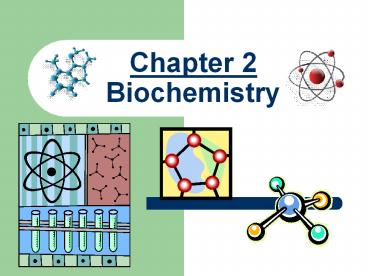Chapter 2 - PowerPoint PPT Presentation
Title: Chapter 2
1
Chapter 2Biochemistry
2
Cooperative Activity Work together to write
what you know about the terms
- Group 1
- Enzyme
- Proton
- Electron
- Group 2
- Neutron
- Element
- Compound
- Group 4
- Reactant
- Product
- Chemical Reaction
- Group 3
- Atom
- Molecule
- Bond
3
Basic Chemistry
- Living things are made up of matter all matter
is composed of atoms
4
Composition of Matter
- Elements are made of atoms
- Elements bond to make compounds
5
Chemical Bonds
- Force that holds two or more atoms together
6
Types of Bonds
- Ionic Holds ions together (salt)
- Covalent Holds molecules together (water)
- Van der Wall FORCE NOT a bond, weak force (Gecko
feet)
7
Ch 2.2 Properties of Water
- Water is neutral
- Polar slight charge why it is a good
conductor
8
Water Bonding
- Polarity makes water bond with
- itself ? Hydrogen Bond
- Cohesion How it bonds w/same substance (water
strider) - Adhesion How it bonds w/different substances
(capillary action) - H2O is VERY cohesive adhesive!
9
Cohesion
Adhesion
10
Mixtures
- Solution
- Solute (What's dissolved)
- Solvent (what's doing the dissolving - typically
Water) - Suspension mixture where parts aren't
completely dissolved
11
Water can form Ions
- Hydroxide Ion OH-
- Hydrogen Ion H
Acid PH lt7
Base PH gt7
Buffers controls pH levels
12
(No Transcript)
13
Ch 2.3 Molecules of Life
14
You Are What You Eat
15
You Are What You Eat
- Nutrition Facts label
- a summary of our basic biochemistry
- Why do we need to eat these?
16
Organic Molecules
- Contain carbon
- Macromolecules large molecules
- Held together with covalent bonds
17
Macromolecules are Polymers
- Polymers are molecules held together by covalent
bonds - ? Made of monomers
18
Four categories of macromolecules
- Proteins
- Carbohydrates
- Lipids
- Nucleic Acids
19
Proteins
- Subunits amino acids
- Proteins differ in
- , type arrangement of amino acids
20
What do proteins do?
- Enzymes Increase rate of chemical reactions /
lowers activation energy - Ex. Amylase converts starch to simple sugar
21
What do proteins do? (cont.)
- 2. Transport Hemoglobin (red blood cell protein)
- 3. Defense Antibodies
22
What do proteins do? (cont.)
- 4. Structure Collagen, Ligaments, Tendons
- 5. Regulation Hormones
- Ex. Insulin glucose regulation
23
What do proteins do? (cont.)
- 6. Motion muscle protein
24
Ch 2.4 Chemical Reactions Enzymes
- Chemical reaction? form new chemical substance
- Chemical bonds change
- of atoms stays the same
- Reactants ? Products
25
Rates of Chemical Reaction
- Energy is needed to start reaction Activation
Energy
26
Reactants
Products
27
Energy Absorbing Reaction
Endothermic / Endergonic
28
Energy Releasing Reaction
Exothermic / Exergonic
29
Energy Enzymes
- Enzymes
- Are proteins
- Help start chemical reactions / catalyst
- Speeds up chemical reactions
- Act on a substrate
30
Regulating Enzyme Function
- pH
- Temperature
31
Carbohydrates
- Provide energy to cells
- Subunit
- glucose
32
Types of Carbohydrates
- Simple carbohydrates
- mono- di-saccharides
- Complex carbohydrates
- polysaccharides
33
Simple Carbohydrates
- Easy to digest
- Examples
- Glucose simple sugar
- Fructose fruit sugar
- Lactose milk sugar
34
Complex Carbohydrates
- Longer to digest
- Long chains of monosaccharides
35
Complex Carbohydrates (cont.)
- Starch
- Glycogen energy storage
- Cellulose plant structure
36
Discussion Questions
- 1. Why should we limit some simple sugars?
- 2. Why do athletes eat complex carbohydrates
before a long run / game?
37
White Boarding What type of carb is each
statement?
- Provide longer amounts of energy
- Provide shorter amounts of energy
- Subunit is glucose (sugar)
- Easier to breakdown / shorter to digest
- Harder to break down / longer to digest
- Can end in ose suffix
- Examples are starch, cellulose glycogen
- Examples are fruits, milk and candy
- Provide energy to the cell
38
Lipids
- Subunit Fatty Acids
- Insoluble in water but soluble in oil
- Important for homeostasis
39
Function of Lipids
- 1.Energy storage (Fat)
- 2.Regulate body functions
- Steroids Cholesterol, Hormones (testosterone
estrogen)
40
Function of Lipids (cont.)
- 3. Provide structure in cells waxy coating on
plants
41
(No Transcript)
42
Saturated Fats
- Called triglyceride
- Hard solid at room temp
- Ex. Meat, Dairy, Butter, Chocolate, Animal Fats
43
Unsaturated Fats
- Kinked carbon chain
- Liquids at room temp
- Ex. Peanuts, Fish, Olive Oil
44
Saturated v.s. Unsaturated
45
Trans Fats
- Worst type of fat
- Increases risk of heart problems
46
Discussion Questions
- Which type of fats should we eat less of?
- How many calories must you burn to lose 1 lb of
fat?
47
Question Answers
- Saturated trans fats linked to heart disease
- 3,500 calories!!!
48
White Boarding What type of fat is each
statement
- Stores energy
- Solid at room temperature
- Liquid at room temperature
- Helps maintain homeostasis
- Key part of cell membrane
- Ex animal fat, butter, chocolate,
- Ex fish, olive oil, nuts
- Full of ch bonds
- Double bond so it is kinked
- Linked to heart disease
- Better type of fat
- Aka triglyceride
49
Nucleic Acids
- Subunit
- Nucleotide
- Two types
- DNA RNA
50
DNA
- Deoxyribonucleic acid
- Store genetic information
- Double helix
51
RNA
- Ribonucleic Acid
- Helps synthesize (create) proteins
52
Concept MapLink these words together
- Carbohydrates Proteins Nucleic Acids
- Lipids Fatty Acids Glucose
- Amino Acids Nucleotides Store energy
- Useable energy Polymers Saturated
- Unsaturated Covalent Bonds
- Simple DNA, RNA
- Carries hereditary information
- Fructose, Starch, Gylcogen, Cellulose
- Butter, Fish, Oils
- Complex Make Enzymes, Muscles, Hemoglobin, Etc































